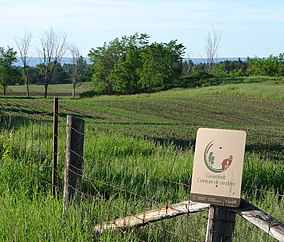Greenbelt (Ottawa)
| (Ottawa) Greenbelt | |
|---|---|
 |
|

Map of Ottawa showing the Greenbelt surrounding the urban core
|
|
| Location | Eastern Ontario, Canada |
| Nearest city | Ottawa |
| Area | 203.5 km2 (78.6 sq mi) |
| Established | 1956 |
| Governing body | National Capital Commission |
| http://www.canadascapital.gc.ca/bins/ncc_web_content_page.asp?cid=16297-16299-9735&lang=1 | |
The Greenbelt (French: Ceinture de verdure) is a 203.5 square kilometres (78.6 sq mi) crescent of land within the present-day boundaries of the city of Ottawa, Ontario, Canada, in which real estate development is strictly controlled. It begins at Shirleys Bay in the west and extends to Green's Creek in the east. 149.5 square kilometres (57.7 sq mi) of the greenbelt is owned and managed by the National Capital Commission (NCC) and the rest is held by other federal government departments and private interests.
The greenbelt was proposed by Jacques Gréber in 1950 as part of his master plan for Ottawa, and the federal government started expropriating land in 1956. Its original purpose included the prevention of urban sprawl (which was threatening the rural areas surrounding the city), as well as to provide open space for the future development of farms, natural areas and government campuses. At the time, the greenbelt was "intended to circumscribe an area large enough for the accommodation of some 500,000 persons. The inner limit was chosen by considering what area could be economically provided with municipal services."
The present City of Ottawa comprises an extensive urban area surrounded by an even more extensive rural zone, a situation brought about by the January 1, 2001 amalgamation of Ottawa with several surrounding municipalities, both urban and rural. As a result, the Greenbelt no longer surrounds Ottawa, but rather it forms an arc through the inside of the city.
Today, land cover within the current Greenbelt comprises mainly forest, wetland, and fields - all with mixed use for recreation, conservation, farming, research, forestry. It also includes limited urban development, including government buildings and the Ottawa/Macdonald-Cartier International Airport. To date, the Ottawa Greenbelt is among the largest urban parks in the world.
The Greenbelt's success in curbing urban sprawl is difficult to measure because it is not known what the city would have looked like without it. As Ottawa had a population of 859,704 in 2005, it has clearly grown beyond what Gréber planned that the greenbelt should hold. Greenbelt detractors commonly reference the former city of Kanata, which lies just to the west of the greenbelt, as proof that development leapfrogged the greenbelt.
...
Wikipedia
